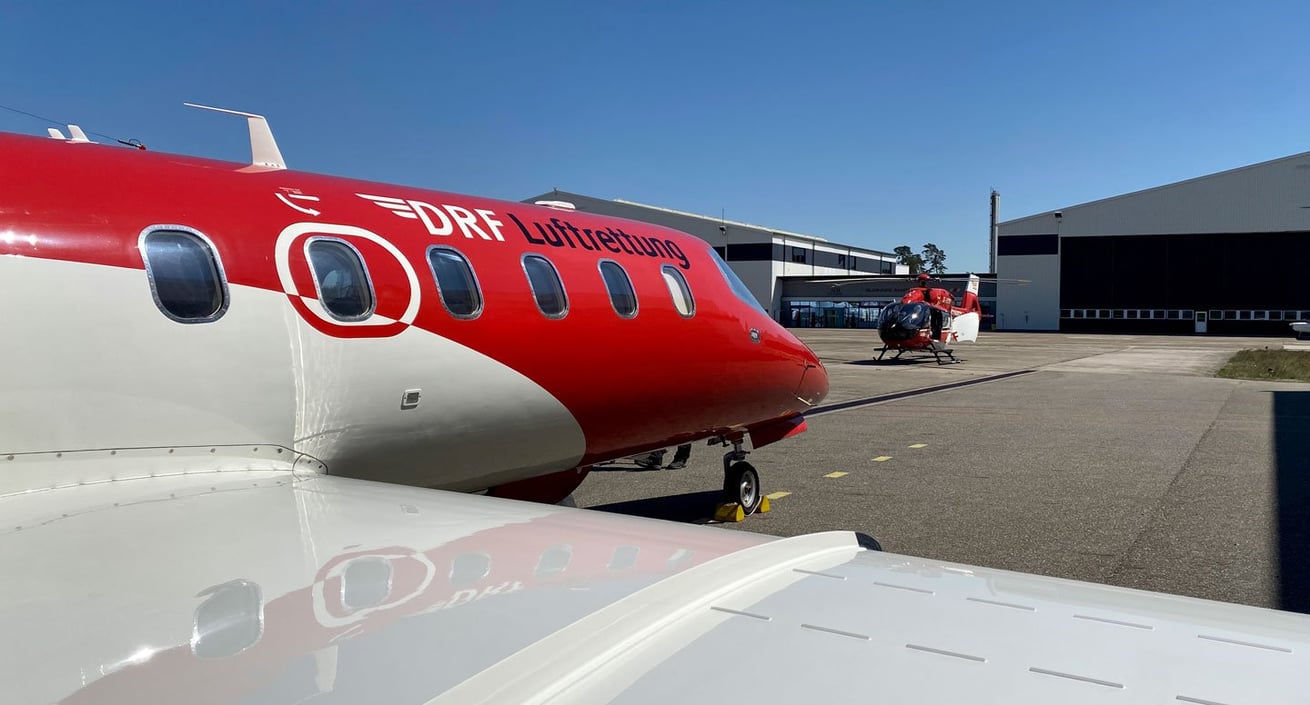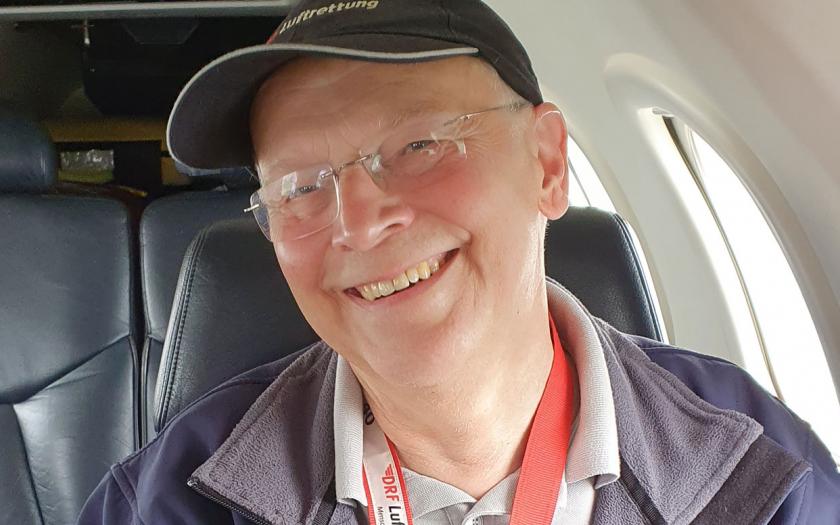All for one: cross-border solidarity
Solidarity is more important than ever during the coronavirus pandemic, and it does not stop at national borders: after successful treatment in Germany, a patient returns home to France with the help of DRF Luftrettung.

At Karlsruhe/Baden-Baden Airport, the helicopter crew took over the patient from the Learjet team. (Source: DRF Luftrettung)
At the beginning of spring, the coronavirus already had Europe firmly in its grip. During this time, DRF Luftrettung impressively demonstrated that it can be relied on - even in crisis situations and for cross-border operations. This was also the case at the end of April, with the repatriation of a French patient from Dresden to France. The cooperation of many stakeholders contributed to his state of health improving significantly during the treatment in Germany. They all worked together so that he could be brought back home. The expertise of DRF Luftrettung in patient transport with Learjets and intensive care helicopters was especially beneficial in this particular case.
The request for the repatriation came from a French control centre, which was specifically set up for all medical transports of French patients back to their homeland. The DRF Luftrettung operations centre checked the conditions for patient transport, and immediately initiated the required measures.
"Our missions involving formerly positive patients who have tested negative after treatment are assessed by an additional doctor who is a coronavirus specialist," said Dennis Wittmann, who supervised the relocation as mission coordinator for the Learjet. "This assessment was the basis for initiating the transport with the ambulance aircraft – the weather conditions in the Dresden region did not allow transport via helicopter." During the planning, the crew identified a further challenge at the destination in France: the nearest airport was an hour’s drive away from the hospital. So the coordination centre in Metz offered the use of a small military airport directly at the destination. However, the runway there was too short for the ambulance aircraft. "As a result, we came up with the idea to transport the patient to Karlsruhe/Baden-Baden with the Learjet, and then directly to the clinic with 'Christoph 111'," said Wittmann.
The reduced transport time as a result was a blessing for the patient.Dennis Wittmann, Mission Coordinator
One day later, the Learjet took off in Dresden. Dr Johannes Meyer accompanied the repatriation in his role as an emergency doctor: "The patient was handed over on the runway," said the doctor. During the trip from the University Hospital Carl Gustav Carus to Dresden Airport, Meyer received information that the patient had been diagnosed with bacteria with problematic resistance: an infection risk for people with weakened immune systems. However, this did not pose a problem for the Learjet medical crew. "We informed the admitting hospital in France," explained Meyer. "In such a situation, comprehensive preparations must be made by the hospital."
Thomas Münsterer, pilot of the "Christoph 111" intensive care transport helicopter, which was also deployed, said: "International flights are rather rare. However, there was excellent cooperation from the French air traffic control. And the cooperation with the aviation safety authorities was also excellent, which enabled us to always fly via the direct route."
.jpg?width=840&height=525&name=R%C3%BCckverlegung_DresdenFrankreich_%C3%9Cbergabe-RHM_4%20(1).jpg)
Handover of the patient at Karlsruhe/Baden-Baden Airport. (Source: DRF Luftrettung)
"So that everyone in the team knew the medical history of the patient, the patient handover from the Learjet to the helicopter crew took place 'wing to wing' on the apron of Karlsruhe/Baden-Baden Airport.
Only then did we calmly move the patient and make all the preparations for the flight," explained emergency paramedic Stephan Nusser. "The French language skills of the emergency doctor were also helpful for this." During the flight, the patient was constantly provided with oxygen, and there was also permanent monitoring by means of ECG and pulse oximeter. The patient was ultimately transferred successfully to the destination hospital.

Emergency doctor Dr Johannes Meyer has already been in the service of DRF Luftrettung for more than 40 years. (Source: DRF Luftrettung)
Emergency doctor Dr Meyer, who accompanied a total of three patients on their way back to their homeland, is still moved by these experiences today: "All three were severely ill. None of them had personal items or identification documents with them. A patient at the German clinic received a patient diary from the intensive care unit, with photos and greetings from the staff there. We found this very moving, because it expressed the emotional involvement and support."
Used for the mission
- a Learjet 35A ambulance jet Learjet crew: two pilots,
- emergency paramedic, emergency doctor
- an H145 helicopter
- crew of "Christoph 111": pilot, emergency paramedic, emergency doctor operations centre: three mission coordinators
Author: Eva Baumann - Press officer

Telephone: +49 711 7007 2205
Email: presse@drf-luftrettung.de